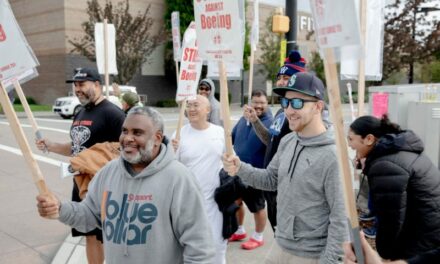We support our Publishers and Content Creators. You can view this story on their website by CLICKING HERE.
By Lucia Mutikani
WASHINGTON (Reuters) – New applications for U.S. unemployment aid unexpectedly fell last week, but the number of people collecting benefits in mid-October was the highest in nearly three years, indicating it was becoming harder for those losing jobs to land new positions.
The second straight weekly drop in filings for state unemployment benefits reported by the Labor Department on Thursday likely reflected an ebb in claims from Hurricane Helene, which earlier this month had boosted applications to the highest level in nearly 1-1/2 years. There is a still a chance that claims could rise in the weeks ahead as the impact on the labor market from Hurricane Milton has yet to be felt.
Given the distortions from the hurricanes as well as an ongoing strike at Boeing, economists expected Federal Reserve officials to shrug off any decline in nonfarm payrolls or rise in the unemployment rate when they meet next month. The employment report for October will be published days before Americans head to the polls on Nov. 5 to elect a new president.
“The labor market is softening but not imploding,” said Carl Weinberg, chief economist at High Frequency Economics. “Fed policy is aimed at supporting the economy and the job market before a recession shapes up. Gradual easing to achieve that goal may achieve it.”
Initial claims for state unemployment benefits dropped 15,000 to a seasonally adjusted 227,000 for the week ended Oct. 19, the Labor Department said on Thursday. Economists polled by Reuters had forecast 242,000 claims for the latest week.
Unadjusted claims declined by 22,634 to 202,635 last week. A jump of 4,275 in filings in Florida was more than offset by significant decreases in Georgia, North Carolina, New York, Texas as well as Tennessee, Ohio and Michigan.
Though the hurricanes and the strike have obscured the labor market view, there does not appear to be a major material shift.
The Fed’s “Beige Book” report on Wednesday described employment as having “increased slightly” in early October, “with more than half of the districts reporting slight or modest growth and the remaining districts reporting little or no change.”
It also noted that “many districts reported low worker turnover, and layoffs reportedly remained limited” adding that “demand for workers eased somewhat, with hiring focused primarily on replacement rather than growth.”
Boeing’s unionized West Coast workers voted on Wednesday to reject a proposed new contract that included a 35% pay hike over four years and enhanced contributions to workers’ 401(k) retirement plans.
CONTINUING CLAIMS RISE
The number of people receiving benefits after an initial week of aid, a proxy for hiring, rose 28,000 to a seasonally adjusted 1.897 million during the week ending Oct. 12, the highest level since mid-November in 2021, the claims report showed.
The so-called continuing claims covered the period during which the government surveyed households for October’s unemployment rate. Continuing claims increased between the September and October survey weeks.
The jobless rate dropped to 4.1% in September from 4.2% in August. Its rise from 3.4% in April 2023 to 4.3% in July this year was the trigger for the U.S. central bank’s unusually large 50-basis-point rate cut last month.
The first reduction in borrowing costs since 2020 lowered the Fed’s policy rate to the 4.75%-5.00% range. The Fed hiked rates by 525 basis points in 2022 and 2023 to curb inflation. It is expected to cut rates by 25 basis points next month.
(Reporting by Lucia Mutikani; Editing by Chizu Nomiyama, Andrea Ricci and Paul Simao)

 Conservative
Conservative  Search
Search Trending
Trending Current News
Current News 





